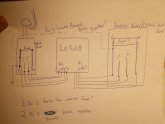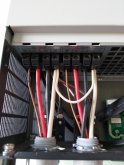SolarBro
Solar Budgeteer
- Joined
- Jun 27, 2020
- Messages
- 91
I'm working on slow install of my LV-5048 and I had a question and a crude diagram of my question.
1. Do I bond my Neutral and Ground on the critical loads panel?
2. Should I run a ground wire from my main service panel to my Critical loads panel grounding bar?
Im not sure how MPP solar handles grounding internally in the unit. So I wanted to know who has worked with MPP units to handing where they bond G/N together if they are also receiving grid inputs and not purely off-grid.
Thank you!

1. Do I bond my Neutral and Ground on the critical loads panel?
2. Should I run a ground wire from my main service panel to my Critical loads panel grounding bar?
Im not sure how MPP solar handles grounding internally in the unit. So I wanted to know who has worked with MPP units to handing where they bond G/N together if they are also receiving grid inputs and not purely off-grid.
Thank you!




